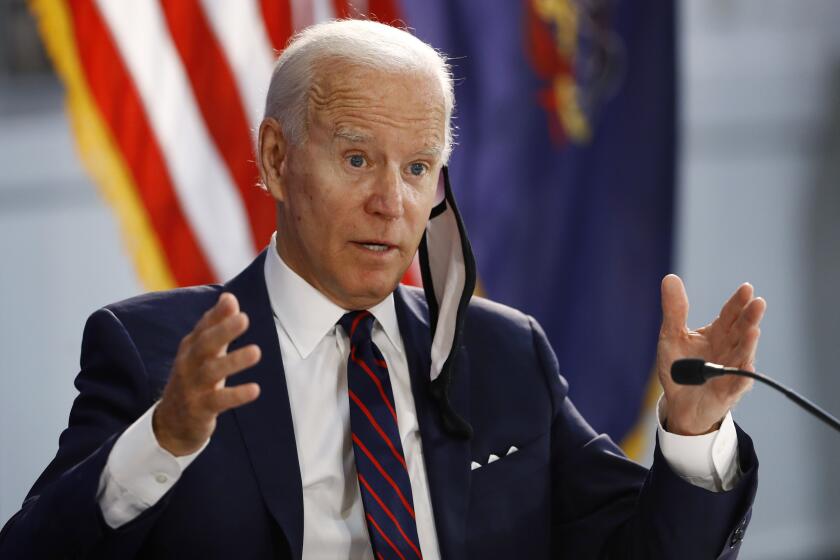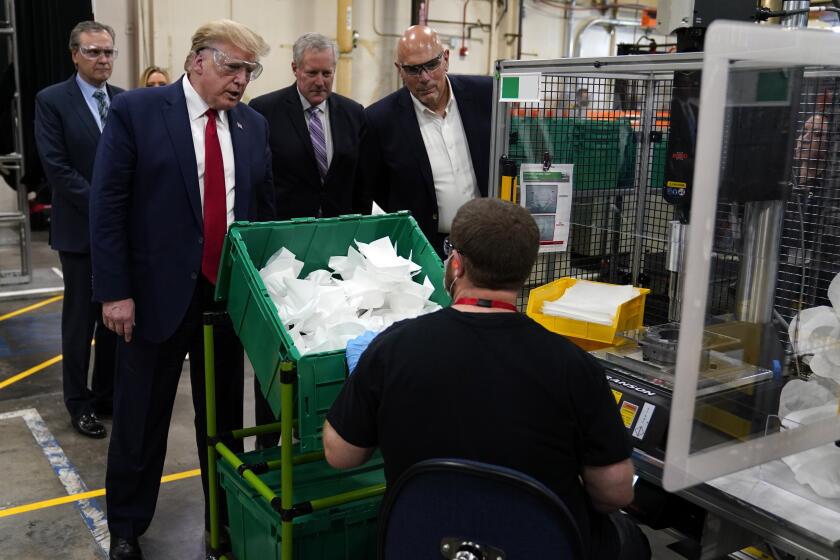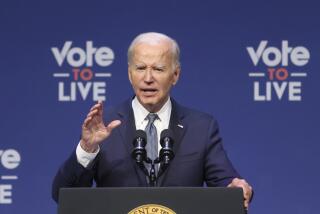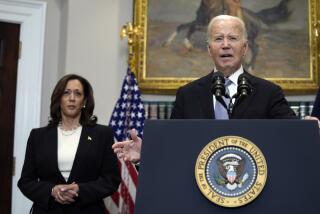In Trump vs. Trump, the winner is Joe Biden
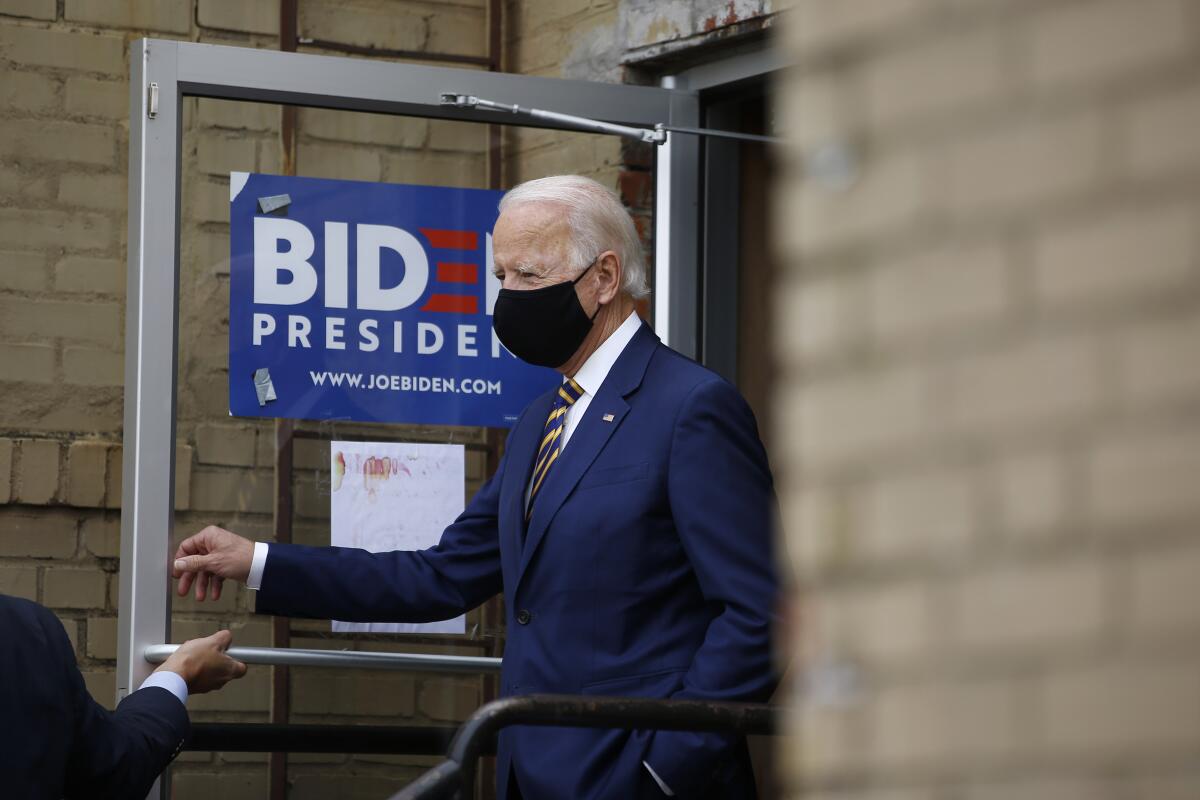
- Share via
WASHINGTON — As President Trump skids in the polls, Joe Biden has amassed a lead in so many battleground states that he is competing in places once considered out of reach, narrowing the president’s path to reelection.
But for all Biden’s good fortune, there is a catch: Voters are not so much upbeat about him as they are upset with Trump. Many, in fact, don’t know much about the prospective Democratic nominee, despite his decades in high office, and some Democrats warn that Biden shouldn’t rely too heavily on Trump’s self-destructiveness to keep propelling him forward.
“The biggest challenge is filling in Joe Biden,” said Robert Gibbs, a former advisor to President Obama. “People know he was the vice president, but not a lot else.”
It is a concern broadly shared among Democratic operatives, even as earlier doubts about Biden have melted away. His once-anemic campaign war chest is bulging as money floods in, and states including Georgia and Texas that long seemed out of reach are suddenly on the battle map. Weaknesses in the campaign’s infrastructure — such as a lackluster social media operation — have been addressed, and Biden is more sure-footed on the virtual campaign trail.
But his lead has undeniably been driven more by anti-Trump animus than anything Biden has done. A CNN poll this month that had Biden ahead by 55% to 41% found that 3 out of 5 Biden voters said they were casting their ballot against Trump; just 37% said it would be a pro-Biden vote.
Biden insists he will not run as just an anti-Trump candidate, and has promised to detail a New Deal-style economic agenda. For now, however, the campaign has seemed eager to keep the spotlight on the president’s many unforced errors.
That’s what most Democratic TV ads are doing, according to UC Berkeley political scientist David Broockman. His analysis of ad spending between early April and late May found 88% of ads aired by Democrats and pro-Biden super PACs were attacks on Trump, and only 11% promoted Biden.
That could leave an opening for the Trump campaign, which has so far struggled to settle on a line of attack, to try to weaken Biden through the sort of name-calling and provocative accusations so associated with the president.
“Right now the election is Trump versus Trump, and Trump is losing badly,” said William Galston, a Brookings Institution scholar who has been an advisor on six Democratic presidential campaigns. “If it turns into Trump versus Biden, the president has a chance. Biden needs to do more to define himself in the eyes of the electorate before the Democratic convention in August.”
Cash from donors big and small is gushing into Biden’s campaign, driven by concern over Trump and growing confidence in the Democrat’s operation.
Biden aides are confident he can fend off Trump attacks. They note that the president’s campaign has already spent tens of millions of dollars on attacks that have failed to stick — tying Biden to the party’s far left, to a contrived scandal Trump called “Obamagate” or to alleged misdeeds involving Ukraine.
“For months now, Donald Trump and his allies have tried flinging desperate and discredited attacks against Vice President Biden, and for months Biden has continued to grow his lead,” campaign spokesman Mike Gwin said. “The American people know Joe Biden, and they know Biden’s the right candidate in this moment of crisis to unite our country, combat the coronavirus, and rebuild the middle class.”
The Biden campaign on Thursday announced a $15-million, five-week investment in advertising — the first major ad expenditure of the contest against Trump. One of the ads, launching Friday in six states that Trump won in 2016, includes footage of the president’s controversial photo opportunity brandishing a Bible in front of a church across from the White House, after federal police and others forcefully cleared the area of peaceful protesters against police brutality.
“I won’t traffic in fear and division,” Biden says in the ad. “I won’t fan the flames of hate. I’ll seek to heal the racial wounds that have long plagued our country, not use them for political gain.”
In recent campaign events, as well, Biden has focused on drawing a contrast between how he and Trump have responded to the current crises: Biden wears a mask to prevent COVID-19 spread; Trump does not. Biden visited with George Floyd’s grieving family after the Black man was killed by police in Minneapolis; Trump met with police officers. Biden is limiting his exposure to people; Trump is beginning to hold in-person campaign rallies.
Rep. Ruben Gallego (D-Ariz.) said it pays for the Biden campaign to keep the spotlight on Trump’s stumbles. “I think the expression is never try to catch a falling knife,” he said.
In the three months since his last Democratic rival quit the once-crowded field, Biden has struggled. The COVID-19 pandemic shut down the economy and drove him off the campaign trail. Fundraising dried up. All campaign communications emanated from the basement of his Delaware home.
That is now changing. Biden and the Democratic National Committee raised almost $81 million in May, up more than 30% from April. He has begun to travel to hold carefully managed campaign events. And as Trump has floundered in his handling of the pandemic and widespread protests against police brutality, Biden’s prospects have brightened.
The former vice president now enjoys a 8.5-percentage-point advantage nationwide, according to the RealClearPolitics average of polls — the widest lead all year. And he is surging in battleground states Democrats need to win the White House. Polls in Michigan show Biden ahead by more than 8 points. He is sustaining a lead of several points in Pennsylvania, and Democrats are also ahead in Arizona, a longtime Republican stronghold that has become a battleground in this cycle.
Fresh polling shows the race a toss-up in some states where Trump was thought to have a formidable advantage — Georgia, Texas and Iowa among them. Even Kentucky is now considered competitive.
“The challenge we have is the challenge every presidential campaign wants to have,” said Tom Perez, chairman of the Democratic National Committee. He called it “the challenge of too much opportunity.”
The shifting map also is affecting plans of pro-Biden groups including Planned Parenthood Action Fund and the Lincoln Project, a super PAC of anti-Trump Republicans.
“This is happening at the best possible time for Biden and worst possible time for Trump,” said Mike Madrid, a strategist with the Lincoln Project, which is now advertising in Kentucky, Iowa, Texas and Ohio.
The Biden campaign and its allies are investing heavily in Arizona. Gallego, who is helping organize that effort, said they are eager to avoid the mistake of Democrat Hillary Clinton’s campaign, which waited until late in the 2016 race to invest there and then lost the state narrowly.
Democrats believe Arizona is trending their way, and a Biden victory there could offset Trump’s electoral college gains if he remains strong in the Midwest.
While Biden has benefited from the wide name identification he enjoys from having been vice president, Democratic strategists say many Americans remain uncertain about exactly what he stands for, and what he would do as president.
Biden has released many detailed plans, including those recently on race relations and reopening the economy. But it has been hard for him to get any message through while most Americans are preoccupied with more pressing health and economic concerns — and Trump’s latest controversy.
In a Wall Street Journal/NBC News poll this month, 25% of voters said they felt neutral about Biden or didn’t know him; only 9% had no judgment about Trump.
“People think that because Joe Biden has been in politics for 40 years and been vice president that everyone knows who he is,” said Sarah Longwell, a strategist who founded Republican Voters Against Trump and has conducted focus groups of swing voters. “But there are a lot of people have a really fuzzy outline of him.”
Gibbs, the former Obama aide, says he worries that even as Trump’s support erodes, some polls show voters still have more confidence in the president to deal with the economy. Biden needs to say more about his vision for the economy, Gibbs said, and about the experience he’s had that has equipped him to handle it.
Biden has repeatedly promised to roll out a new, more ambitious economic agenda. But that has been delayed in favor of focusing on the deaths of George Floyd and Rayshard Brooks and the ensuing protests for police reform, as well as the ongoing pandemic.
“There will be time to talk about an agenda that I, as an economist, think is extremely important,” said Jared Bernstein, a senior fellow at the Center on Budget and Policy Priorities who is advising Biden. “We don’t want to lose the contrast between the extreme damage done by Trump’s terrible leadership and the alternative that the Biden presidency would present.”
More to Read
Get the L.A. Times Politics newsletter
Deeply reported insights into legislation, politics and policy from Sacramento, Washington and beyond. In your inbox three times per week.
You may occasionally receive promotional content from the Los Angeles Times.
